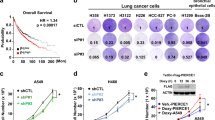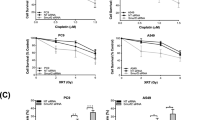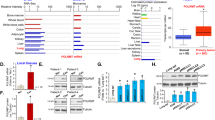Abstract
In this report, we have demonstrated that Wnt-2 protein is overexpressed in freshly resected human non-small-cell lung cancer (NSCLC) tissues. We have also developed a monoclonal antibody against the N-terminus of human Wnt-2 protein. This monoclonal antibody induces apoptosis in human NSCLC cell lines that overexpress Wnt-2 protein. Incubation of this antibody with normal human airway cells lacking Wnt-2 expression does not induce apoptosis. Wnt-2 signaling blockade by the anti-Wnt-2 antibody is confirmed by downregulation of cytosolic β-catenin and reduction in TCF-dependent transcriptional activity (TOPFLASH assay). In addition, Wnt-2-specific small interfering RNA (siRNA) treatment in the NSCLC cell line A549 also downregulated cytosolic β-catenin and induced apoptosis. Moreover, downregulation of an inhibitor of apoptosis family protein, Survivin, was noticed both in the Wnt-2 antibody- and siRNA-treated NSCLC cells, suggesting that inhibition of Wnt-2-mediated signaling induces apoptosis through inactivating Survinin.
This is a preview of subscription content, access via your institution
Access options
Subscribe to this journal
Receive 50 print issues and online access
$259.00 per year
only $5.18 per issue
Buy this article
- Purchase on Springer Link
- Instant access to full article PDF
Prices may be subject to local taxes which are calculated during checkout




Similar content being viewed by others
References
Bienz M and Clevers H . (2000). Cell, 103, 311–320.
Blasband A, Schryver B and Papkoff J . (1992). Oncogene, 7, 153–161.
Chai J, Du C, Wu JW, Kyin S, Wang X and Shi Y . (2000). Nature, 406, 855–862.
Chen S, Guttridge DC, You Z, Zhang Z, Fribley A, Mayo MW, Kitajewski J and Wang CY . (2001). J. Cell Biol., 152, 87–96.
Dale TC, Weber-Hall SJ, Smith K, Huguet EL, Jayatilake H, Gusterson BA, Shuttleworth G, O'Hare M and Harris AL . (1996). Cancer Res., 56, 4320–4323.
Dann CE, Hsieh JC, Rattner A, Sharma D, Nathans J and Leahy DJ . (2001). Nature, 412, 86–90.
Elbashir SM, Harborth J, Weber K and Tuschl T . (2002). Methods, 26, 199–213.
He TC, Sparks AB, Rago C, Hermeking H, Zawel L, da Costa LT, Morin PJ, Vogelstein B and Kinzler KW . (1998). Science, 281, 1509–1512.
Holcombe RF, Marsh JL, Waterman ML, Lin F, Milovanovic T and Truong T . (2002). Mol. Pathol., 55, 220–226.
Hsieh JC, Rattner A, Smallwood PM and Nathans J . (1999). Proc. Natl. Acad. Sci. USA, 96, 3546–3551.
Huguet EL, McMahon JA, McMahon AP, Bicknell R and Harris AL . (1994). Cancer Res., 54, 2615–2621.
Ioannidis V, Beermann F, Clevers H and Held W . (2001). Nat. Immunol., 2, 691–697.
Jemal A, Tiwari RC, Murray T, Ghafoor A, Samuels A, Ward E, Feuer EJ and Thun MJ . (2004). CA Cancer J. Clin., 54, 8–29.
Katoh M . (2001). Int. J. Oncol., 19, 1003–1007.
Kim PJ, Plescia J, Clevers H, Fearon ER and Altieri DC . (2003). Lancet, 362, 205–209.
Li F, Ambrosini G, Chu EY, Plescia J, Tognin S, Marchisio PC and Altieri DC . (1998). Nature, 396, 580–584.
Minna JD, Roth JA and Gazdar AF . (2002). Cancer Cell, 1, 49–52.
Nusse R and Varmus HE . (1982). Cell, 31, 99–109.
Olie RA, Simoes-Wust AP, Baumann B, Leech SH, Fabbro D, Stahel RA and Zangemeister-Wittke U . (2000). Cancer Res., 60, 2805–2809.
Orford K, Orford CC and Byers SW . (1999). J. Cell Biol., 146, 855–868.
Peifer M and Polakis P . (2000). Science, 287, 1606–1609.
Pham K, Milovanovic T, Barr RJ, Truong T and Holcombe RF . (2003). Mol. Pathol., 56, 280–285.
Polakis P . (2000). Genes Dev., 14, 1837–1851.
Reya T, O'Riordan M, Okamura R, Devaney E, Willert K, Nusse R and Grosschedl R . (2000). Immunity, 13, 15–24.
Satoh S, Daigo Y, Furukawa Y, Kato T, Miwa N, Nishiwaki T, Kawasoe T, Ishiguro H, Fujita M, Tokino T, Sasaki Y, Imaoka S, Murata M, Shimano T, Yamaoka Y and Nakamura Y . (2000). Nat. Genet., 24, 245–250.
Shih IM, Yu J, He TC, Vogelstein B and Kinzler KW . (2000). Cancer Res., 60, 1671–1676.
Shimizu H, Julius MA, Giarre M, Zheng Z, Brown AM and Kitajewski J . (1997). Cell Growth Differ., 8, 1349–1358.
Smith K, Bui TD, Poulsom R, Kaklamanis L, Williams G and Harris AL . (1999). Br. J. Cancer, 81, 496–502.
Srinivasula SM, Datta P, Fan XJ, Fernandes-Alnemri T, Huang Z and Alnemri ES . (2000). J. Biol. Chem., 275, 36152–36157.
Tetsu O and McCormick F . (1999). Nature, 398, 422–426.
Uematsu K, Kanazawa S, You L, He B, Xu Z, Li K, Peterlin BM, McCormick F and Jablons DM . (2003). Cancer Res., 63, 4547–4551.
Uthoff SM, Eichenberger MR, McAuliffe TL, Hamilton CJ and Galandiuk S . (2001). Mol. Carcinog., 31, 56–62.
Veeman MT, Axelrod JD and Moon RT . (2003). Dev. Cell, 5, 367–377.
Vider BZ, Zimber A, Chastre E, Prevot S, Gespach C, Estlein D, Wolloch Y, Tronick SR, Gazit A and Yaniv A . (1996). Oncogene, 12, 153–158.
Wang CY, Guttridge DC, Mayo MW and Baldwin Jr AS . (1999). Mol. Cell. Biol., 19, 5923–5929.
Wodarz A and Nusse R . (1998). Annu. Rev. Cell Dev. Biol., 14, 59–88.
You Z, Saims D, Chen S, Zhang Z, Guttridge DC, Guan KL, MacDougald OA, Brown AM, Evan G, Kitajewski J and Wang CY . (2002). J. Cell Biol., 157, 429–440.
Zhang T, Otevrel T, Gao Z, Ehrlich SM, Fields JZ and Boman BM . (2001). Cancer Res., 61, 8664–8667.
Acknowledgements
This work was supported by the Larry Hall memorial trust and the Kazan, McClain, Edises, Abrams, Fernandez, Lyons & Farrise Foundation.
Author information
Authors and Affiliations
Corresponding author
Rights and permissions
About this article
Cite this article
You, L., He, B., Xu, Z. et al. Inhibition of Wnt-2-mediated signaling induces programmed cell death in non-small-cell lung cancer cells. Oncogene 23, 6170–6174 (2004). https://doi.org/10.1038/sj.onc.1207844
Received:
Revised:
Accepted:
Published:
Issue Date:
DOI: https://doi.org/10.1038/sj.onc.1207844
Keywords
This article is cited by
-
WNT ligands in non-small cell lung cancer: from pathogenesis to clinical practice
Discover Oncology (2023)
-
Emerging Importance of Survivin in Stem Cells and Cancer: the Development of New Cancer Therapeutics
Stem Cell Reviews and Reports (2020)
-
A Ras destabilizer KYA1797K overcomes the resistance of EGFR tyrosine kinase inhibitor in KRAS-mutated non-small cell lung cancer
Scientific Reports (2019)
-
The effect of GnRH antagonist cetrorelix on Wnt signaling members in pubertal and adult mouse ovaries
Histochemistry and Cell Biology (2019)
-
Transcription factor PAX6 as a novel prognostic factor and putative tumour suppressor in non-small cell lung cancer
Scientific Reports (2018)



